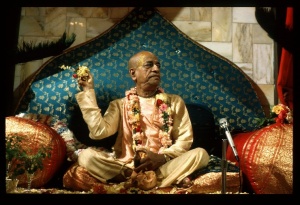SB 10.9.3

A.C. Bhaktivedanta Swami Prabhupada
TEXT 3
- kṣaumaṁ vāsaḥ pṛthu-kaṭi-taṭe bibhratī sūtra-naddhaṁ
- putra-sneha-snuta-kuca-yugaṁ jāta-kampaṁ ca subhrūḥ
- rajjv-ākarṣa-śrama-bhuja-calat-kaṅkaṇau kuṇḍale ca
- svinnaṁ vaktraṁ kabara-vigalan-mālatī nirmamantha
SYNONYMS
kṣaumam — saffron and yellow mixed; vāsaḥ — mother Yaśodā was wearing such a sari; pṛthu-kaṭi-taṭe — surrounding her large hips; bibhratī — shaking; sūtra-naddham — bound with a belt; putra-sneha-snuta — because of intense love for her child, became wet with milk; kuca-yugam — the nipples of her breasts; jāta-kampam ca — as they were very nicely moving and quivering; su-bhrūḥ — who had very beautiful eyebrows; rajju-ākarṣa — by pulling on the rope of the churning rod; śrama — because of the labor; bhuja — on whose hands; calat-kaṅkaṇau — the two bangles were moving; kuṇḍale — the two earrings; ca — also; svinnam — her hair was black like a cloud, so perspiration was dropping like rain; vaktram — throughout her face; kabara-vigalat-mālatī — and mālatī flowers were dropping from her hair; nirmamantha — thus mother Yaśodā was churning the butter.
TRANSLATION
Dressed in a saffron-yellow sari, with a belt tied about her full hips, mother Yaśodā pulled on the churning rope, laboring considerably, her bangles and earrings moving and vibrating and her whole body shaking. Because of her intense love for her child, her breasts were wet with milk. Her face, with its very beautiful eyebrows, was wet with perspiration, and mālatī flowers were falling from her hair.
PURPORT
Anyone who desires to be Kṛṣṇa conscious in motherly affection or parental affection should contemplate the bodily features of mother Yaśodā. It is not that one should desire to become like Yaśodā, for this is Māyāvāda. Either in parental affection or conjugal love, friendship or servitorship—in any way—we must follow in the footsteps of the inhabitants of Vṛndāvana, not try to become like them. Therefore this description is provided here. Advanced devotees must cherish this description, always thinking of mother Yaśodā's features—how she was dressed, how she was working and perspiring, how beautifully the flowers were arranged in her hair, and so on. One should take advantage of the full description provided here by thinking of mother Yaśodā in maternal affection for Kṛṣṇa.